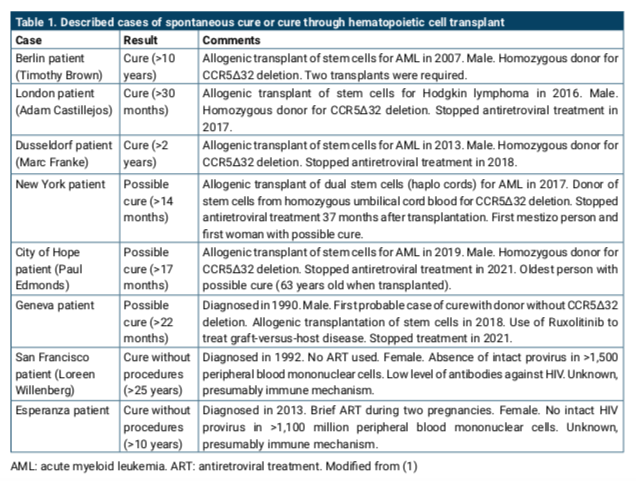Cure for HIV: How far are we?
Abstract
The possibility of finding a cure for HIV/AIDS has been contemplated since the beginning of that pandemic 40 years ago. This possibility became tangible in 2009 with the description of the “Berlin patient”, a person with HIV whose infection was eradicated by means of a bone marrow transplant from a CCR5∆32 donor as part of his treatment for leukemia. Since then, five new potential cases of cure with similar procedures have been reported (Table 1) (1). However, in addition to the lack of a preventive vaccine, there is still no effective and scalable cure for all people with HIV.
Before attempting to provide an answer to the recurrent question of how far we are from a cure, we will first mention why it is so important and why so many efforts and resources are devoted to finding it. Great progress has been made in the treatment of HIV, allowing people who live with this virus to maintain viremia suppressed at undetectable levels, and avoid the pathogenic consequences of viral replication and transmission to other people. Multiple prevention strategies combined at population level have also been developed to reach the greatest possible number of individuals. However, there are still 39 million people living with HIV in the world (140,000 in Argentina) and 1.3 million infections occur every year (5,300 in Argentina) (2, 3). In fact, according to the latest data released by UNAIDS, the annual number of new infections has increased by 8% in Latin America and the Caribbean, compared to the data from 2010. In addition, we know that access to treatment is not optimal. Only 70% of the people have access globally (2). We should also add the toxicities associated with antiretroviral therapy and the cost of the drugs that not all governments cover in full. Finally, stigma, criminalization and discrimination still exist. It is therefore clear that having a cure could put an end to several of these problems.
Multiple barriers that prevent the cure of HIV have been identified with the tools currently available: the so-called viral reservoir (cells where the virus genome, provirus, persists during the patient’s whole life), the persistent replication of the virus in spite of adequate antiretroviral therapy, and the persistence of the virus in certain anatomic “sanctuary” places (4). The virus in the reservoir is not accessible to antiretroviral treatment or to the mechanisms effecting the immune response. Moreover, the cells forming the reservoir are difficult to identify, quantify, and characterize. This has led to a situation where finding a cure to the infection has become a huge challenge, covering not only the development of therapeutic procedures (and strategy combinations) but also the need to continue with basic and clinical studies that enable us to understand viral reservoirs, viral control immune mechanisms, and the study of different viral populations, genera, and subtypes in depth (5).
Research conducted so far in “elite controllers” (individuals that control viral replication in the absence of treatment) and “post-treatment controllers” (those who, after having received treatment for some time, control viral replication in its absence) has provided information and orientation. Major differences have been identified in the composition, activity, and location of the reservoir among people with HIV and different biological sex or different coinfections. Multiple technological developments have allowed us to understand better how HIV latency is established and how the virus is reactivated after interrupting treatment, and new drugs and procedures have been developed and have started to show a certain degree of success in phase-I pre- clinical and clinical models (6).
In 2021, the International AIDS Society proposed two new concepts related to the cure of HIV: remission and eradication. They define the term “remission” as the long-lasting control of the virus in the absence of any antiretroviral treatment, and “eradication” as viral control plus complete elimination of the intact virus competent for replication (5). It is important to point out, however, that the concept of cure has many meanings in and outside the scientific field. For example, different studies in the field of social science have reported that, for certain groups of people with HIV, cure is associated with the possibility of not transmitting the infection or the possibility of maintaining viral control through treatment.
So far, the only procedure that has proved to reduce the size of the viral reservoir is the start of antiretroviral treatment very early during the infection. However, except for the scenario of perinatal diagnosis, it is not frequent to identify individuals during primary infection to allow us to expand this strategy. Other procedures aim at modifying the already established reservoirs, either by managing to reactivate the cells containing provirus, leading to viral transcription and later elimination by the immune system (shock and kill), or to their permanent silencing (block and lock). A much more radical approach to eliminating the provirus implies the use of genic therapy, whose purpose is to eliminate the viral sequences integrated to the genome with techniques such as CRISPR-Cas9. On the other hand, multiple strategies focusing on the immune system are being developed. Most of them have the purpose of enhancing the capacity of T cells to recognize HIV and control its replication in the absence of treatment. Others focus on administering combinations of broadly neutralizing antibodies that help to control viral rebound in the absence of antiretrovirals and, ideally, also reduce or eliminate the reservoirs when combined with other procedures that aim at viral reactivation (1).
The points we have developed show that there are numerous obstacles to achieve the final goal. Despite different procedures under development, there is still a lot of work to do. On the one hand, strengthen research into infection with HIV not only in Argentina but in the whole Latina American and Caribbean region as well. Ignoring the characteristics and needs of our own population will lead to delays in the implementation of any effective development. It is clear that we must pave the way and insert our countries in the HIV cure agenda. It is also clear that, in order to eradicate the infection, we must not only eliminate the virus but also all the inequalities and inequities that feed its dissemination.

Downloads






